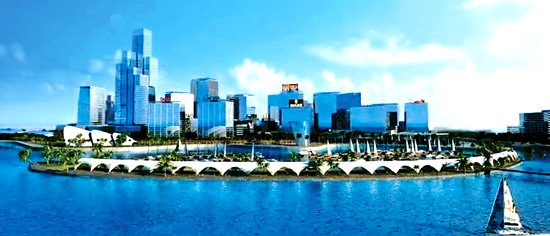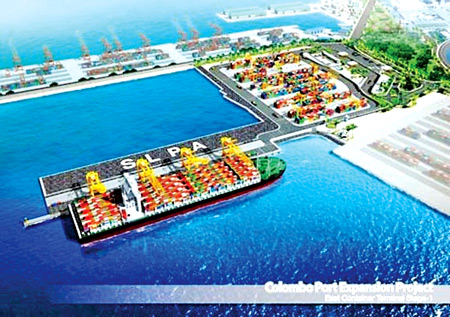Colombo port city project, a reality soon
By Shirajiv Sirimane
It was our ancestors that first discovered the value of the shipping
industry and this was how the 'silk route' was created making the then
Ceylon a naval hub in the world. The foreign invaders took a cue from
this and redeveloped the harbour network not for the love of Sri Lanka
but to use the harbours for their economic gain.
 However in the late 1960s the harbour sector suffered severe setbacks
with a series of strikes which drove away the competitive edge the
Colombo harbour had in the region. However in the late 1960s the harbour sector suffered severe setbacks
with a series of strikes which drove away the competitive edge the
Colombo harbour had in the region.
Capitalising on these factors both Dubai and Singapore reinvested
heavily to redevelop their harbour network and successfully managed to
be the two key ports to major shipping lines to the world. Some of the
stalwarts in the local shipping industry had urged successive
governments to reinvest in the harbour network but these proposals were
only confined to the drawing boards.
Chairman Master Divers, Ariyaseela Wickramanayake said that he even
spent his own money to do a feasibility study on a proposed harbour to
Hambantota and had forwarded them to several political leaders but with
no avail.
"It was only when I gave it to the then Prime Minister Mahinda
Rajapaksa that things started moving and a harbour was finally opened
allowing Sri Lanka to once again gain a competitive advantage as a
regional shipping hub. "I still say this project is 10 years behind
time. But its better late than never as the country is slowly but surely
is reaping economic benefits from this project," he said.
Sacrifice
Similar plans for the re-development of the Colombo Port have once
again begun. These two harbours have allowed Sri Lanka to slowly but
surely regain status as a world maritime hub.
To add more teeth to the plan 'Sri Lanka - a world maritime hub', a
harbour city plan is to be re-implemented.
The plan for the Colombo harbour city project was first drawn up by
the UNP government that was in power during the 2004 era. Under this
plan 233 hectares were to be acquired in Colombo area which included
land from Slave Island, Mattakkuliya Kotahena, Peliyagoda and also a
part of Galle Face.
|

Port City layout |
However, knowing the plight of the people who would have had to
sacrifice over 230 acres of living space President Rajapaksa drew up a
plan to get this space by reclaiming land from the sea. This was how the
Port City project came in to the limelight.
Imagine the relocation of 233 hectares of prime residence and
business establishments from the heart of Colombo if the former proposal
was in place. This meant that another 233 hectares of land from city had
to have been sacrificed from the city for relocation.
But now without relocation Sri Lanka is getting around 233 hectares
of additional land and the country would be a proud owner of a new
island!
However its sad to note that the very people who wanted to 'rob' 233
acres from the people of Colombo and create a port city are now crying
foul for these projects that not only bring economic benefits, but help
elevate the country which not only builds highways but also artificial
islands.
Chairman Port Authority (SLPA) Dr. Priyath Wickrama said that Port
City project would be the single biggest private sector development in
the history of Sri Lanka. The biggest advantage of this project is that
the government does not have to spend a single cent to create this
island.
Free
The developers would also provide free of charge 125 hectares of land
to the SLPA. "From this land we can pay all our lands we obtained to
build the Colombo South Harbour, Hambantota, Oluvil and for development
for Galle and Trincomalee," he said.
"ÓSLPA is expected to earn investments worth US $ 20 billion via
other investments within this land extent. It will also generate a large
number of employment opportunities. Sri Lanka Ports Authority (SLPA)
will receive a large financial benefit by granting these land extents on
long term lease that will enable SLPA in return, to pay back all the
loans it has obtained and become the pioneer institute that strengthens
the State financial status."
The developer gets 20 hectares as a grant to cover their costs and
the balance on a 99 year lease.
The investment in its initial stage for the project comes to US$
1,340 million which is US$ 1.34 billion. This project would include a
3.25km long breakwater and a large internal artificial canal.
The total land area will be supplied with electricity, consumable
water, roads for transportation, sewerage systems and all other
infrastructure at a level required for an international business centre.
|

East Container Terminal - stage 1 |
Headquarters for shipping and logistics institutions and related
enterprises, luxury hotels and apartment complexes, shopping malls,
space for modern offices, leisure and recreational activities will also
be developed and constructed.
Although some have stated that the project would include a formula
track that drives up to Gampaha, it is apparent that it includes only a
general track that equals to the kind of a course available in Singapore
that utilises the main road to hold such motor races.
Therefore, during the construction of the roads, the project will
consider the inclusion of primary components required to conduct such
motor events.
It is stressed therefore, that this by any means, is not a dedicated
construction to hold formula one events.
Permission
As per an unsolicited proposal forwarded by China Harbour Engineering
Company Ltd; (CHEC) a partnership of the China Communication
Construction Co. Ltd; (CCCC) which falls under Fortune 500 Companies of
the world, has been granted permission to develop the Colombo Port City
Project, including reclamation, breakwater construction, connected road
network and supply of services, under the procedures adhered by the
Government to implement such proposals.
Accordingly, this proposal was primarily submitted for Standing
Cabinet Appointed Review Committee (SCARC) through the Department of
Public Finance for approval, a release from the SLPA said. On the
instructions by the SCARC, Sri Lanka Ports Authority (SLPA) also entered
into a Memorandum of Understanding (MOU) with CCCC and obtained the
detail proposal which was expressed at the Technical Evaluation
Committee (TEC) appointed by SLPA to evaluate the Project Proposal.
The final approval has been granted thereafter, subjected to the
agreement by the Attorney General.Therefore, Sri Lanka Ports Authority (SLPA)
responsibly states that it is totally irresponsible for anyone to state
that this is a hidden project implementation in Sri Lanka.After 1977,
and up to now, various Governments that were in power in Sri Lanka have
granted approval to carry out such implementations following
considerations to the project proposals expressed by similar
institutions and enterprises, with the hope of retaining investors in
the country.
The World Trade Centre in Colombo, Hilton, Galadari and Taj Samudra
hotel projects are only a few examples to such
implementations.Mathematical and Physical Model Tests have been
completed within laboratories of international standard and changes have
also been included upon data presented following the tests. These
breakwaters become crucial due to the fact that the existence of
everyone who lives and resides on these reclamations depend on the
breakwaters constructed here. Therefore, the SLPA has extended its
fullest concern on their constructions, the release further says.
Consultation
The developer agreed to obtain the service of U.R.S. Infrastructure &
Environment U.K. - the consultancy company who conducted the
consultation services of the Colombo Port Expansion Project, to
supervise the breakwaters of the Colombo Port City Project are properly
and accurately planned, and their constructions are carried out
according to accurate procedures is a further assurance granted towards
the safety of the construction of breakwaters of this project. U.R.S.
Infrastructure & Environment U.K. becomes the best institution in this
regard due to its experience of offering consultation to a similar
project since inception.It is inaccurate to mention that the project has
never undergone an environmental evaluation as well.
The Environment Evaluation Certificate for the project was obtained
in December 2011, following compilation of all environmental evaluation
reports and fulfilling all activities therein, adhered to relevant
procedures.
Several concerned personages had raised questions with regard to the
reasons why the project was implemented via SLPA.
This is a large project that involves a land reclamation which
requires breakwater protection and look after the marine environment.
Sri Lanka Ports Authority is the only institution in Sri Lanka who
possesses experience and technical expertise to implement and carry out
such activities.
It is further important to sustainably maintain the canal and
artificial beach constructed here and SLPA is the only arm that
possesses required machinery and trained manpower for this work.
Therefore, SLPA itself implements the entire project. Many parties'
and persons' reports of various issues pertaining to the investor
company of the project were countered and answered by the company itself
via media.
The total investment in this regard is invested by the relevant
company with a greater concern over the project and 125 hectares of land
area out of the total land area of 233 hectares will be owned by the
Government of Sri Lanka, whilst the rest will be retained by the company
to cover their costs of expenditure, whereas only 20 hectares come under
the company's full ownership whilst the rest will be handed over under
99 year lease basis.
The investor should hand over these lands to other investors under a
99 year lease basis to sustain expenditure and earn revenue.
Procedure
Accordingly, the investor, at the initial stage owns only the sea
bed. The procedure in this regard therefore, will be leasing the sea
bed. With additions of interest to the total project expenditure, the
cost will be US $ 1,918 million. Divided by the land extent owned by the
investor company, the investor should spend Rs.5.8 million for a perch
of sea bed. To receive the internal rate of return of the investment as
at 16 percent, one hectare of land extent should be valued at US $ 24
million. The value is Rs.7.8 million for a perch.
Therefore, the minimum value of one perch here is Rs. 8 million. As
the land extent is not exposed at the market at once, the market value
of the lands will not be reduced. Similar projects could be seen
elsewhere in the world where investors have been granted with better
benefits and conveniences. Instances are also apparent where investors
have been offered with the total administration of such projects.
However, in this project, the total administrative responsibility is
vested upon Sri Lanka Ports Authority (SLPA), the Board of Investment
and the Urban Development Authority. |

